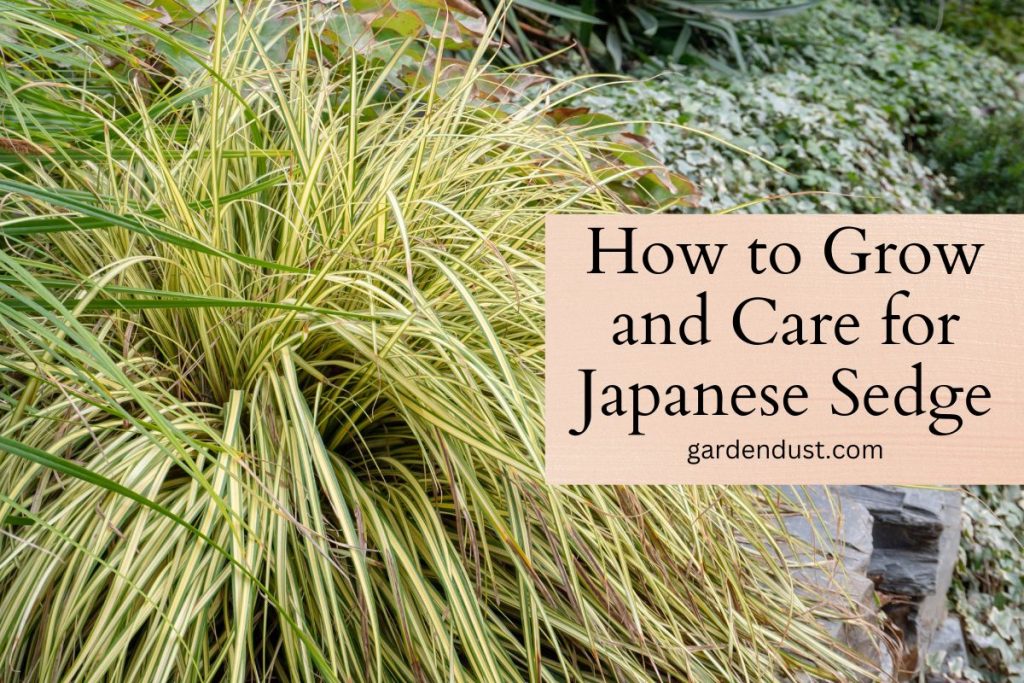Japanese Sedge (Carex morrowii), also known as “Morrow’s Sedge” or “Japanese Grass,” is a versatile and attractive ornamental grass that has gained popularity in gardens around the world. Originating from Japan, this low-maintenance perennial adds a touch of elegance and texture to landscapes. In this comprehensive guide, we will explore the How to Grow and Care for Japanese Sedge. Let’s start…
Botanical Name-Carex morrowii
Native-Japan
Genus– Carex
Family: Cyperaceae
Common Name: Japanese Sedge, Morrow’s Sedge, Japanese Grass
Plant Type-Perennial Ornamental Grass
Plant Size– Typically 12 to 18 inches in height, forming dense clumps.
Growth Form– Japanese Sedge is characterized by gracefully arching leaves that create an attractive, dense foliage. It is an evergreen perennial, ensuring year-round interest in the garden.
Varieties-
Japanese sedge, or Carex morrowii, is a popular ornamental grass known for its graceful arching habit and attractive foliage. There are several cultivated varieties of Japanese sedge, each with unique characteristics. Here are some notable varieties:
- ‘Aurea’ (Golden Variegated Japanese Sedge)
- ‘Ice Dance’
- ‘Variegata’ (Variegated Japanese Sedge)
- ‘Evergold’
- ‘Silver Sceptre’
- ‘King Tut’
- ‘Fisher’s Form’
- ‘Gold Band’
- ‘Spark Plug’
- ‘Piglet’
READ ALSO:-How To Grow English Ivy
Grow and care for Japanese Sedge
Sunlight Requirements-
Japanese Sedge thrives in partial to full shade but can tolerate some sunlight. Ideally, plant it in an area that receives dappled sunlight or filtered shade. Avoid planting in intense, direct sunlight, as it may scorch the leaves.
Soil Conditions-
Japanese Sedge prefers well-drained, moist soil with a slightly acidic to neutral pH. Amending the soil with organic matter, such as compost, improves drainage and fertility. Avoid waterlogged conditions, as they can lead to root rot.
Planting Japanese Sedge
- Timing: Plant Japanese Sedge in the early spring or fall when the weather is mild. This allows the plant to establish its roots before facing extreme temperatures.
- Spacing: Space the plants according to their mature size, typically ranging from 12 to 18 inches apart. This ensures proper air circulation and prevents overcrowding.
- Planting Depth: When planting Japanese Sedge, match the depth of the nursery container. Gently loosen the roots before placing the plant in the hole and backfill with soil. Water thoroughly to settle the soil around the roots.
Watering and Mulching
- Watering Needs: Japanese Sedge appreciates consistently moist soil. Water regularly, especially during dry periods. Avoid overwatering, as this can lead to root diseases. Mulching helps retain moisture and regulates soil temperature.
- Mulching Benefits: Apply a layer of organic mulch, such as shredded bark or compost, around the base of the plant. Mulching not only conserves moisture but also suppresses weeds and enhances the soil’s organic content.
Pruning & Division
- Pruning Frequency: Japanese Sedge is a low-maintenance plant, but occasional pruning helps maintain its shape and appearance. Trim back any damaged or discolored leaves in late winter or early spring before new growth emerges.
- Division: Every few years, consider dividing mature clumps to rejuvenate the plant. Division is best done in the early spring. Lift the plant, separate the root ball into sections, and replant the divisions.
Fertilizing Japanese Sedge
- Minimal Fertilization: Japanese Sedge generally doesn’t require heavy fertilization. In early spring, apply a balanced, slow-release fertilizer to provide essential nutrients for healthy growth.
- Organic Alternatives: Consider using organic fertilizers or well-rotted compost to promote soil fertility naturally. Organic amendments enhance the soil structure and support the overall well-being of the plant.
Common Pests and Diseases
- Pest Resistance: Japanese Sedge is relatively resistant to pests. However, keep an eye out for slugs, snails, and aphids, especially in humid conditions. Use environmentally friendly pest control methods if needed.
- Disease Prevention: To prevent fungal diseases, ensure good air circulation by spacing plants appropriately. Avoid overhead watering, as wet foliage can contribute to diseases. If necessary, treat with fungicides according to the manufacturer’s instructions.
Winter Care
- Cold Hardiness: Japanese Sedge is generally hardy in USDA zones 5-9. In colder regions, provide a layer of mulch to protect the plant from winter extremes. Evergreen varieties offer added interest during the winter months.
- Container Planting: If you live in a colder climate or have limited space, consider growing Japanese Sedge in containers. Move the containers to a sheltered location or insulate them during the winter to prevent frost damage.
Uses-
- Versatility: Japanese Sedge’s adaptable nature makes it suitable for various landscape applications. Use it as a ground cover, border plant, or in woodland gardens. Its graceful foliage contrasts beautifully with other plants.
- Companion Plants: Pair Japanese Sedge with shade-loving companions like hostas, ferns, and heucheras for a harmonious woodland garden. The variety of leaf colors and textures will create a visually appealing landscape.
Japanese Sedge, with its graceful arching leaves and low-maintenance nature, is a valuable addition to any garden. By understanding its specific needs and following proper care practices, you can enjoy the beauty and versatility of this ornamental grass throughout the year. Whether used as a ground cover or a focal point in your landscape, Japanese Sedge adds a touch of elegance and tranquility to your outdoor space. Happy Gardening…






